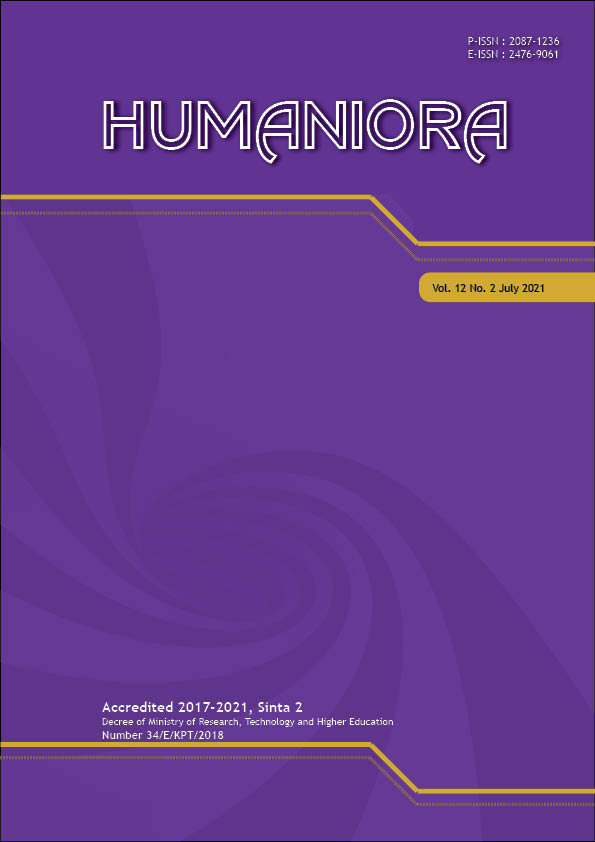Intercultural Communication Competence: An International Students Experience in Indonesia
DOI:
https://doi.org/10.21512/humaniora.v12i2.6999Keywords:
intercultural communication competence, interactive multicultural building model, foreign studentsAbstract
The research aimed to analyze the intercultural communication competence based on international students’ experience in Indonesia and discussed how, in the globalization era, education had reached a new stage where the process of knowledge exchange had crossed national borders. However, educational institutions were not fully prepared to accommodate these modern needs. Although the study of intercultural communication was not new, concern for new cultural diversity had only received great attention lately, wherein the end, the Intercultural Communication Competence (ICC) in educational fields was still very low and must continue to be explored. The research applied a case and phenomenological study method with a descriptive qualitative approach. The data were gathered through semi-structured interviews and study literature. By analyzing the interactive multicultural building model, supported by the concept of intercultural communication and internationalization of higher education, the research results show that there are still inequalities and differences of opinion as well as an assessment of a three-perspective model that is used as the research focus. It consists of the affective process (intercultural sensitivity), cognitive process (intercultural awareness), and behavioral process (intercultural adroitness). Besides, there are various challenges that must be faced.
References
Abidin, H. (2017). Mahasiswa asing seputar Indonesia. Retrieved from https://nasional.sindonews.com/read/1214773/18/mahasiswa-asing-1497830164.
Afrizal. (2014). Metode penelitian kualitatif. Jakarta: Rajagrafindo.
Arowana, A. (2016). Targetkan 20.000 mahasiswa asing, ini saran Kemenristek Dikti untuk semua perguruan tinggi. Retrieved from https://malangvoice.com/targetkan-20-000-mahasiswa-asing-ini-saran-kemenristek-dikti-untuk-semua-perguruan-tinggi/.
Astuti, K. (2017). Izin belajar mahasiswa asing dipermudah. Retrieved from https://www.republika.co.id/berita/pendidikan/dunia-kampus/17/05/12/optv7e361-izin-belajar-mahasiswa-asing-dipermudah.
Barrett, M., Byram, M., Lázár, I., Mompoint-Gaillard, P., & Philippou, S. (2014). Developing Intercultural Competence Through Education. CELT: A Journal of Culture, English Language, 5(1), 27-41.
Bedenlier, S., & Zawacki-Richter, O. (2015). Internationalization of higher education and the impacts on academic faculty members. Research in Comparative and International Education, 10(2), 185-201. https://doi.org/10.1177/1745499915571707.
Cai, L., & Teng, L. (2014). Towards cross-cultural adaptation of international students: A case study of Chinese students in Finland. BioTechnology: An Indian Journal, 10(9), 4047-4053.
Chen, G. M. (2010). The impact of intercultural sensitivity on ethnocentrism and intercultural communication apprehension. Intercultural Communication Studies, 19(1), 1-9.
Chen, G. M., & Starosta, W. J. (1996). Intercultural communication competence: A synthesis. Annals of the International Communication Association, 19(1), 353-383. https://doi.org/10.1080/23808985.1996.11678935.
Chen, G. M., & Starosta, W. J. (2000). The development and validation of the intercultural sensitivity scale. Human Communication, 3(1), 1-15.
Chelliah, S., Khan, M. J., Krishnan, T., Kamarulzaman, M. E. B. M., & Goh, N. E. (2019). Factors influencing satisfaction and revisit intention among international exchange students in Malaysia. Journal of International Education in Business, 12(1), 111-130. https://doi.org/10.1108/JIEB-07-2018-0026.
Creswell, J. W. (2014). Research design: Qualitative, quantitative, and mixed methods approaches. USA: Sage publications.
Dimandja, O. O. (2017). “We are not that different from youâ€: A phenomenological study of undergraduate Muslim international student campus experiences. Doctoral Dissertation, USA: University of Colorado Colorado Springs.
Effendy, O. U. (2017). Ilmu komunikasi teori dan praktek. Bandung: Remaja Rosdakarya.
Farquhar, J. D. (2012). Case study research for business. London: Sage Publications Ltd.
Findlay, A. M., King, R., Smith, F. M., Geddes, A., & Skeldon, R. (2011). World class? An investigation of globalization, difference and international student mobility. Transactions of the Institute of British Geographers, 37(1), 118-131. https://doi.org/10.1111/j.1475-5661.2011.00454.x.
Fitriyah, U., Munir, A., & Retnaningdyah, P. (2019). Intercultural communicative competence in ELT: Lecturers’ perception and practice. IJET (Indonesian Journal of English Teaching), 8(1), 62-71. https://doi.org/10.15642/ijet2.2019.8.1.62-71.
Gareis, E. (2012). Intercultural friendship: Effects of home and host region. Journal of International and Intercultural Communication, 5(4), 309-328. https://doi.org/10.1080/17513057.2012.691525.
Gopal, A. (2011). Internationalization of higher education: Preparing faculty to teach cross-culturally. International Journal of Teaching Learning in Higher Education, 23(3), 373-381.
Gu, Q., Schweisfurth, M., & Day, C. (2010). Learning and growing in a “foreign†context: Intercultural experiences of international students. Compare, 40(1), 7-23. https://doi.org/10.1080/03057920903115983.
Guo, S., & Chase, M. (2011). Internationalization of higher education: Integrating international students into Canadian academic environment. Teaching in Higher Education, 16(3), 305-318. https://doi.org/10.1080/13562517.2010.546524.
Holliday, A. (2011). Intercultural communication and ideology. California: SAGE Publications Inc.
Irwandi, I. (2017). Integrating intercultural communication competence in teaching oral communication skill. Proceedings of ISELT FBS Universitas Negeri Padang, 5, 246-252.
Jon, J. E. (2013). Realizing internationalization at home in Korean higher education: Promoting domestic students’ interaction with international students and intercultural competence. Journal of Studies in International Education, 17(4), 455-470. https://doi.org/10.1177/1028315312468329.
Liliweri, A. (2014). Sosiologi dan komunikasi organisasi. Jakarta: Bumi Aksara.
Liu, S., Volcic, Z., & Gallois, C. (2014). Introducing intercultural communication: Global cultures and contexts. London: Sage.
Luthfia, A. (2011). Kompetensi komunikasi antar budaya peserta pelatihan dari Indonesia di Australia. Humaniora, 2(1), 860-866. https://doi.org/10.21512/humaniora.v2i1.3105.
Luthfia, A. (2014). Pentingnya kesadaran antarbudaya dan kompetensi komunikasi antarbudaya dalam dunia kerja global. Humaniora, 5(1), 9-22. https://doi.org/10.21512/humaniora.v5i1.2976.
Maringe, F., & Foskett, N. (Eds.). (2012). Globalization and internationalization in higher education: Theoretical, strategic, and management perspectives. London: A&C Black.
Martin, J. N., & Nakayama, T. K. (2015). Reconsidering intercultural (communication) competence in the workplace: A dialectical approach. Language and Intercultural Communication, 15(1), 13-28. https://doi.org/10.1080/14708477.2014.985303.
Neal, S., Bennett, K., Cochrane, A., & Mohan, G. (2013). Living multiculture: Understanding the new spatial and social relations of ethnicity and multiculture in England. Environment and Planning C: Government and Policy, 31(2), 308-323. https://doi.org/10.1068/c11263r.
Neuliep, J. W. (2018). Intercultural communication: A contextual approach. Thousand Oaks, California: Sage Publications, Inc.
Nurhadi, Z. F., Hendrawan, H., & Ayutria, D. F. (2019). Model komunikasi antar budaya keluarga mixed marriage di wilayah Budapest-Hungaria. Jurnal ASPIKOM, 3(6), 1140-1152. https://doi.org/10.24329/aspikom.v3i6.331.
Penbek, Åž., Åžahin, D. Y., & Cerit, A. G. (2012). Intercultural communication competence: A study about the intercultural sensitivity of university students based on their education and international experiences. International Journal of Logistics Systems and Management, 11(2), 232-252. https://doi.org/10.1504/IJLSM.2012.045425.
Perry, L. B., & Southwell, L. (2011). Developing intercultural understanding and skills: Models and approaches. Intercultural Education, 22(6), 453-466. https://doi.org/10.1080/14675986.2011.644948.
Pinto, S. (2018). Intercultural competence in higher education: Academics’ perspectives. On the Horizon, 26(2), 137-147. https://doi.org/10.1108/OTH-02-2018-0011.
Rossman, G. B., & Rallis, S. F. (2017). An introduction to qualitative research: Learning in the field. Thousand Oaks, California: Sage Publications.
Smakova, K., & Paulsrud, B. (2020). Intercultural communicative competence in English language teaching in Kazakhstan. Issues in Educational Research, 30(2), 691-708.
Tuleja, E. A. (2016). Intercultural communication for global business: How leaders communicate for success. In Intercultural Communication for Global Business: How Leaders Communicate for Success (pp. 1-320). UK: Taylor & Francis. https://doi.org/10.4324/9781315668642.
Wright, C., & Schartner, A. (2013). “I can’t .. I won’t?†International students at the threshold of social interaction. Journal of Research in International Education, 12(2), 113-128. https://doi.org/10.1177/1475240913491055.
Yu, B., & Wright, E. (2016). Socio-cultural adaptation, academic adaptation, and satisfaction of international higher degree research students in Australia. Tertiary Education and Management, 22(1), 49-64. https://doi.org/10.1080/13583883.2015.1127405.
Downloads
Published
How to Cite
Issue
Section
License
Copyright (c) 2021 Janette Maria Pinariya, Aldila Maharani Sutjipto

This work is licensed under a Creative Commons Attribution-ShareAlike 4.0 International License.
Authors who publish with this journal agree to the following terms:
a. Authors retain copyright and grant the journal right of first publication with the work simultaneously licensed under a Creative Commons Attribution License - Share Alike that allows others to share the work with an acknowledgment of the work's authorship and initial publication in this journal.
b. Authors are able to enter into separate, additional contractual arrangements for the non-exclusive distribution of the journal's published version of the work (e.g., post it to an institutional repository or publish it in a book), with an acknowledgment of its initial publication in this journal.
c. Authors are permitted and encouraged to post their work online (e.g., in institutional repositories or on their website) prior to and during the submission process, as it can lead to productive exchanges, as well as earlier and greater citation of published work.
USER RIGHTS
All articles published Open Access will be immediately and permanently free for everyone to read and download. We are continuously working with our author communities to select the best choice of license options, currently being defined for this journal as follows: Creative Commons Attribution-Share Alike (CC BY-SA)


















